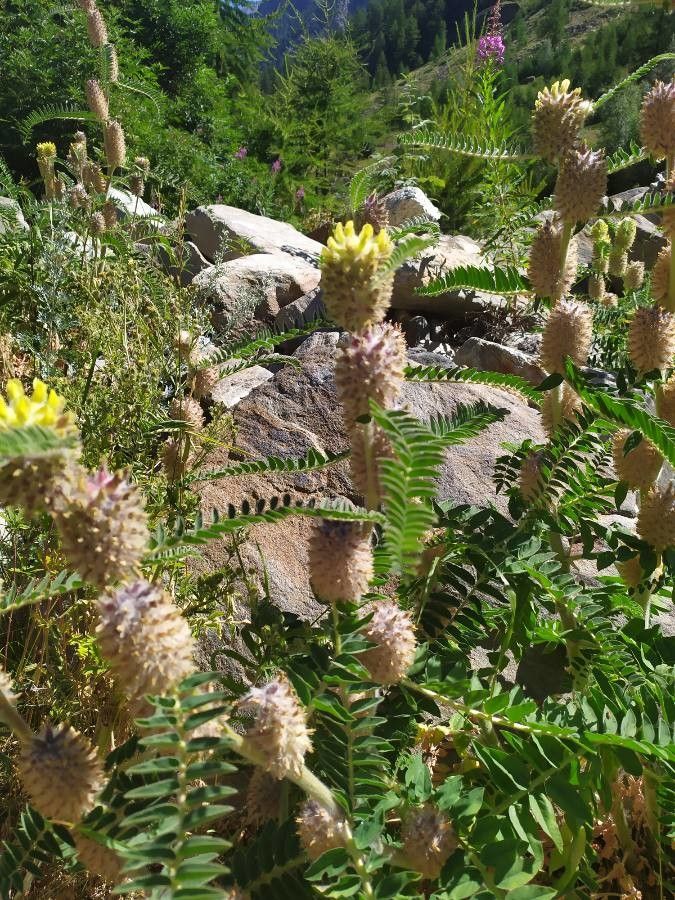Foxtail Milkvetch
astragalus alopecurus
Also known as: ["Foxtail Milkvetch"]
Overview
A perennial herbaceous plant in the legume family, known for its characteristic foxtail-like inflorescence.
Benefits & Perks
["wildlife attractant (bees, butterflies, birds)","drought tolerant"]
Botanical Classification
| Phylum: | Magnoliophyta |
| Class: | Magnoliopsida |
| Order: | Fabales |
| Family: | Fabaceae |
| Genus: | Astragalus |
| Botanical Name: | Astragalus alopecurus |
Plant Characteristics
Basic Information
- Category: Flowers
- Suitable Location: border plantings or rock gardens in temperate regions
- Suitable For:
- Is Weed: No
- Allergenicity: low
Environmental Needs
- Climate: {"temperatureRange":"–30 to 40°C"}
- Hardiness: {"zones":"3–9"}
- Misting: rarely required, only if ambient humidity is very low
- Drainage: Fast-draining to prevent waterlogging.
- Soil Type: Well-draining, loamy soil with added organic matter.
Maintenance Level
- Maintenance Level: moderate
- Toughness Level: moderate
- Pruning Frequency: Annually in early spring or after flowering.
- Pruning Intensity: Moderate; remove up to one-third of growth if needed.
Care Details
Ideal Sunlight Coverage:
Full sun (6–8 hours/day); tolerates partial shade in hot climates.
Sunlight Tolerance Tips:
Acclimate gradually to intense sunlight; protect from harsh afternoon sun; adjust placement based on seasonal light changes.
Care Requirements
Care Difficulty
moderatemoderate
Sunlight
full sun to partial shade
Rotate plant for even light; use sheer curtains in intense sun; avoid direct indoor light.
Watering
every 7–10 days during active growth, reduce in winter
Water thoroughly but infrequently; ensure soil dries between waterings; avoid overwatering.
Soil
well-drained, sandy loam with moderate organic content
pH: Slightly alkaline to neutral (pH 6.5–7.5).
Use raised beds for drainage; avoid heavy clay soils; amend with organic matter.
Temperature
Prefers 60–75°F (15–24°C); tolerates cooler temperatures but not frost.
Avoid drafts; maintain consistent temperatures; protect from extreme fluctuations.
Fertilizing
every 4–6 weeks during spring and summer
Fertilize only when actively growing; flush soil occasionally to prevent salt buildup; use organic options for slow release.
Propagation
Methods
Stem cuttings or division; seeds can also be used but may be slower.
Step-by-Step Propagation Guide
- Take cuttings.
- Apply rooting hormone.
- Plant in medium.
- Keep moist and warm.
- Transplant once rooted.
Best Time: Spring or early summer when the plant is actively growing.
Environment
Warm, humid environment with indirect light; maintain consistent moisture.
Medium
Well-draining mix of perlite and peat moss or cactus soil.
Hormone
Rooting hormone can be used to speed up root development.
Timeline
Roots may develop in 3–6 weeks; establish in new pot within 2–3 months.
Tools Needed
Pruning shears, rooting hormone, small pots, well-draining medium.
Quick Tips
Use healthy, non-flowering stems; maintain humidity with a plastic cover; avoid overwatering.
Pruning & Repotting
Pruning Guide
Method
Pinch back tips for bushiness; cut back leggy stems to encourage branching.
Pruning Plan
Prune to maintain shape, encourage bushiness, and remove dead or diseased growth.
Tools
Pruning shears, sterilizing solution, gloves.
Checklist
Sterilize tools; prune dead/damaged growth; shape plant; clean up debris.
Repotting Guide
Best Season
Spring, before new growth begins.
Pot Size
Increase pot size by 1–2 inches in diameter.
Method
Remove plant gently; trim roots if necessary; place in new pot with fresh soil; water lightly.
Suggestions
Repot every 2–3 years or when roots fill the pot; beneficial for growth and health.
Checklist
Check root bound status; prepare new pot; use fresh soil; water after repotting.
Advanced Care Tips
Watering Mastery
Watering Checklist
Check soil moisture; water deeply; ensure drainage; adjust for season.
How to Apply Water Properly
Water at the base of the plant, ensuring moisture reaches the root zone; allow excess water to drain away; water in the morning to reduce evaporation.
Watering Schedule Tips
Water deeply once the top inch of soil feels dry; reduce frequency in winter to prevent root rot.
Soil Improvement
Add perlite or sand for drainage; incorporate compost for fertility; ensure good aeration.
Temperature Stress Management
Signs of Temperature Issues
Wilting, leaf drop, or stunted growth in extreme heat or cold.
Cold Stress
Growth slows or halts; may suffer frost damage if temperatures drop below freezing.
Solution: Move to a sheltered location; provide frost protection; avoid sudden temperature drops.
Hot Stress
Leaves may scorch, wilt, or drop; growth may slow in excessive heat.
Solution: Provide shade during peak heat; increase humidity; water more frequently but avoid waterlogging.
Fertilizing Guide
Fertilizing Checklist
Check growth phase; dilute fertilizer; apply to moist soil; avoid contact with roots.
Fertilizing Method
Use balanced liquid fertilizer diluted to half strength every 4–6 weeks during growing season; avoid fertilizing in winter.
Common Problems & Solutions
Toxicity Warning
Cats
Non-toxicAstragalus alopecurus is not considered toxic to cats. There are no documented cases of toxicity in felines after ingestion.
⚡ Toxic If:
if eaten
Dogs
Non-toxicAstragalus alopecurus is not considered toxic to dogs. There are no documented cases of toxicity in canines after ingestion.
⚡ Toxic If:
if eaten
Humans
Non-toxicAstragalus alopecurus is not considered toxic to humans. It has been used in traditional medicine for various purposes without reported adverse effects.
⚡ Toxic If:
if eaten
Frequently Asked Questions
Q: Is Astragalus alopecurus toxic to pets?
A: Reliable information on toxicity to pets is not available.
Q: How does Astragalus alopecurus attract wildlife?
A: It produces nectar-rich flowers that attract bees, butterflies, and birds.
Q: What are the typical care challenges for Astragalus alopecurus?
A: Common issues include yellowing leaves and stunted growth, often due to improper soil conditions or watering.
Quick Reference
| Family: | Fabaceae |
| Care: | moderate |
| Light: | full sun to partial shade |
| Water: | every 7–10 days during activ |
Get Expert Care Tips
Download the Plantious app for personalized care reminders and plant identification!
Google Play App Store








